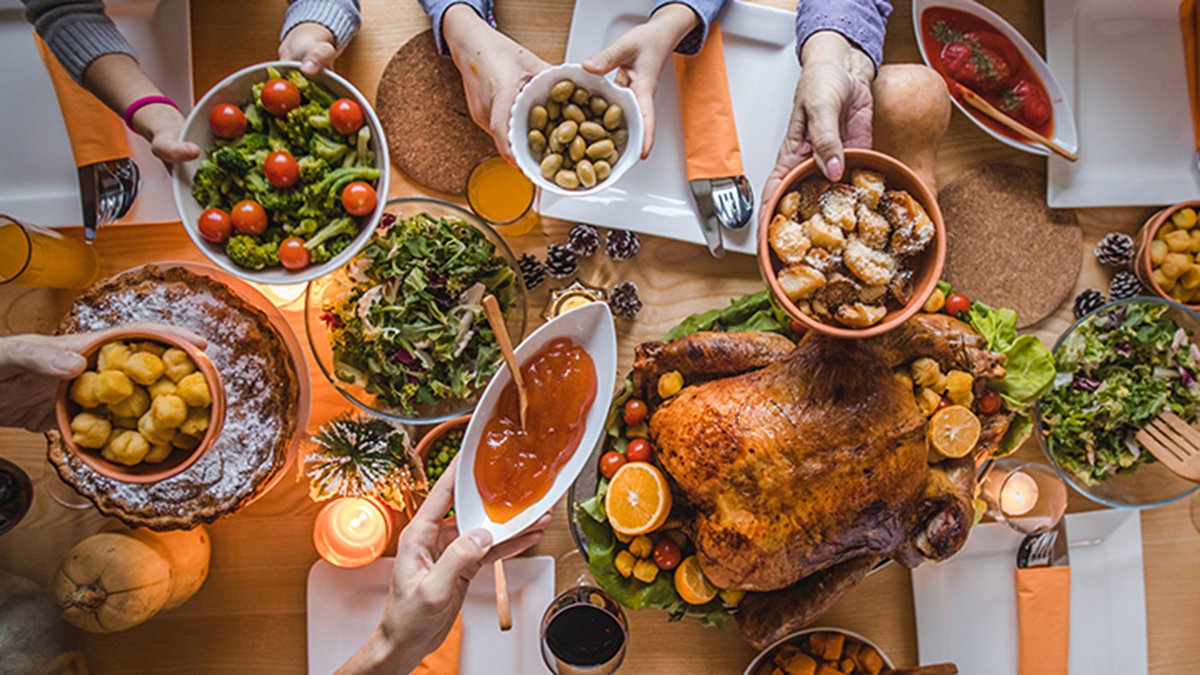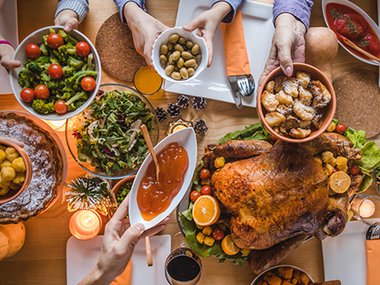Cooking With Chemistry: The Science Behind Your Thanksgiving Meal
Hi, it's Laura Kramer, Manager of Gallery Programming at the Museum, and we are going to talk about the science behind cooking your Thanksgiving meal.
Plan your menu, make your shopping list and dust off your chemistry set because it’s time to get cooking for Thanksgiving! Did I just say chemistry set? Yes, I did! But you don’t need fancy beakers and pipettes to cook your feast. There is already a ton of chemistry going on when you cook your traditional Thanksgiving meal.
The star of any Thanksgiving dinner is a juicy, roasted turkey with a toasty brown crust. That brown crust comes courtesy of the Maillard (pronounced my-yard) reaction.
Dr. L.C. Maillard was the first person to describe the reaction, and therefore became its namesake. Actually, it’s not just one reaction but a complex series of reactions that take place between a sugar and a protein, resulting in the characteristic brown, toasty flavor and texture we expect to see in cooked food. This is why most turkey recipes require you to cover the bird in butter before you cook, and/or baste it in butter while it’s cooking. Butter contains both sugar and protein, and these will undergo the Maillard reaction as it cooks, developing the brown-roasted color we expect to see on our bird.
The Maillard reaction doesn’t work when things are cooked in water, which is why poached chicken doesn’t brown and why the turkey breast I roasted in my crockpot last year for Thanksgiving didn’t brown either (but it was still very good!). The Maillard reaction also works better when things are more basic rather than acidic. If you’ve ever made pretzels, you know you have to boil your bread dough first in a solution of baking soda, and usually cover it in egg. Why do we do that? It’s the Maillard reaction! Cooking it in baking soda makes the food basic, then coating it in egg adds protein that can react with the sugar in the dough. This makes for the characteristic tough brown crust of pretzels.
Are you hungry yet? Did you know that the first step of digestion is to prepare our mouth to start chewing food? We salivate when we think of food because we want to start eating it. Also saliva’s primary job is to get food wet and to start to breakdown starches in the food that we eat. But I digress…that’s a science lesson for another day. Back to the menu!

Image credit: Getty Images
One common ingredient of any feast is diced onion. Do you end up in tears each and every time you cut an onion? Why does that happen?
If you smell an intact onion, does it make you cry? No. Only cut, crushed or modified onions can make you cry. When you cut the onion, you destroy the cells that make it up, and two chemicals that were normally separate mix and react. They create a sulfur-like gas called lachrymator factor that travels up into your eyes and the tears begin! Your body is naturally trying to protect your eyes from the gas, so you cry to help rinse it out and form a protective barrier.
There are a couple tips out there you can do that might help lessen the crying when you chop onions for your Thanksgiving meal. One way is to chill the onion in the fridge before you cut it. Cooling the temperature slows the rate of the chemical reaction. But, if you’re a stickler about flavor, you should know this trick could alter the onion’s flavor. You could also rinse the onion with water once it’s cut. This method will wash the lachrymators away, but this too can slightly alter flavor.
Another way to cut down on the tears is to use a very sharp knife. This helps as it will make a cleaner cut through the onion and break fewer cells, thus releasing less chemicals. You could also use my tried and true method: keep the gas out of your eyes by wearing the safety goggles you bought for chemistry lab in college!
No holiday meal is complete without dessert! My favorite part of Thanksgiving dinner growing up was eating Mom’s apple pie (one of my favorite foods of the season). When watching her cut apple after apple, I noticed that she always put them in a bowl of lemon juice and water. Why do cooks do that?
If you’ve ever left a cut apple out on the table, you know why. Apples are one of the foods that undergo enzymatic browning. When exposed to the oxygen in the air, certain enzymes in the fruit start to oxidize and turn brown. The best way to stop this is to coat the apples in an acid, such as lemon or orange juice once they’re cut. You could also just crush up a Vitamin C tablet (which is ascorbic acid) and add it to the water. The acid slows the reaction, therefore preventing some browning.
Maybe you’re not an apple pie kind of person, and would rather get your carbs from a heaping mound of mashed potatoes. If you’re peeling potatoes for your Thanksgiving meal, know that those also undergo enzymatic browning when exposed to air, as do bananas, pears and avocados.
If you’re looking for a new addition to the Thanksgiving menu this year, you can see chemistry in action in this Butternut Squash Soup. It’s a recipe that our Museum chefs found a few years ago, and we enjoy making it each fall in the Boost! Kitchen. In fact, some staff enjoyed it so much that they prepare it for their Thanksgiving guests each year.
https://www.chowhound.com/recipes/roasted-butternut-squash-soup-30466
The high (400 – 450 degrees) and dry heat of the oven caramelizes the butternut squash. Unlike the Maillard reaction, caramelization is a non-enzymic browning reaction that happens when there is no water and natural sugars break down from the heat. This brings out deep sweet, nutty and toasty flavors in the squash, making it the perfect main ingredient for this delicious soup.
Preparing food is the perfect time to look for science in action in our daily lives. Enjoy your time with friends and family this holiday, and have a yummy science-filled Thanksgiving meal!
